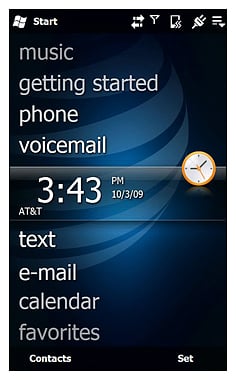Windows Phone 7 Series: Answers and Questions

Microsoft needed to really turn heads today with their Windows Mobile 7 Series presentation. The presentation was critical to squelch the rumors, silence the critics who have ready to announce the death of Windows Mobile and to remain competitive in the Smartphone industry.
Steve Ballmer gave no context for what was to be presented believing it was important to just get on with the show and let Joe Balifore, Microsoft VP in charge of Windows Phones, lead the way in raising the curtain on the 7 Series. "In the end, this is all about the phones and how consumers will react." Balmer said. "It was important to get it (7 Series) out, show what we have now, rather than have it leaked out."
Microsoft needed to breath new life into one of the oldest mobile platforms still in existence. Based on what we saw this morning during the presentation and the hands-on time spent with the new OS, Microsoft did what it needed to do and did it well. Follow the break for more observations and thoughts on Microsoft's' Windows Phone 7 Series presentation.
As several key elements of the 7 Series were revealed, questions and rumors were addressed. Microsoft did a very good job of presenting what they had in place, gave us a sense of direction but as more was revealed, more questions developed.
Here are a few of the topics that stood out from the 7 Series presentation and the questions that were left in the wake.
Consistency

Consistency was a word that dominated the presentation and, dare I say, the consistent theme for the morning. Microsoft has often been criticized for the lack of consistency Windows Mobile has and with 7 Series they are going to develop more "across the board" consistency.
All the latest news, reviews, and guides for Windows and Xbox diehards.
From core hardware specifications to User Interface, Microsoft believes consistency will not only be good for the consumer but also the manufacturer. It will allow them to build phones more quicker and efficiently. While core specifications will be established (screen resolution, touch technology, UI, drivers, etc.) Microsoft's goal is to establish consistency while enabling creativity from their partners. Consistency won't close the door on network specific services.
But will this consistency create conflicts? Will Samsung give up their Widget UI for the 7 Series UI? Will HTC modify their Manilla/Touchflo UI to match the "Hubs" of 7 Series? Will this minimize the "bloatware" that has loaded down Windows Mobile for years or make it more attractive?
Hubs
The Hub concept is designed to place what would take several screens to accomplish on a PC into a compact, organized package on the Windows Phone. Hubs create a destination for common tasks, organizing several applications under one roof. For example, with contacts you have your Outlook contacts, Facebook contacts, and Windows Live contacts. The Contacts Hub on 7 Series pulls all three together under one roof.
From the Hub you can see your recently used contacts, all contacts and a "what's new" feature that reveals any social updates your contacts may have posted on Facebook. The "What's New" feature will allow you to interact with the updated statuses by replying to them.

You will have similar Hubs for Photos, Business, Music, and Games. Each pulling from various sources and offering various avenues of integration.
The Hubs will place a lot of information at your fingertips but it will also create a significant demand on a networks' data service. AT&T was introduced as a primary partner in the Windows Phone 7 Series launch. How much of a data strain will the new 7 Series features put on a network that already has a data intensive phone? One can only hope that with today's announcement carriers will continue to intensify their efforts to increase and improve network coverage.
Windows Mobile 6.5.xx

Ballmer made it clear that Microsoft will continue to invest in Windows Mobile 6.5. What wasn't clear is how long this investment will last or the role Windows Mobile 6.5 will play. We discussed the possibility of two versions of Windows Mobile 7 (business and media). There was no mention of a 7 Series business model so will WM 6.5 eventually turn into a business model? Could Windows Mobile 6.5 find it's way on business/industrial devices such as tablets and inventory control devices?
7 Series clearly has the capability of handling business and personal needs. Will the distinction between media and business come from device design? Will the media model have the larger screen, no keyboard and 3.5mm jack? While the business model come with a smaller screen and front-facing QWERTY keyboard?
And what is to become of Windows Mobile Standard? Is the news from this morning set into motion events that has this OS becoming a thing of the past? With the capacitive screen becoming a core specification, has the EOL of the non-touch screen devices become inevitable?
What was left out?

While the presentation raised the curtain on Windows Phone 7 Series and put to rest many rumors, it still left us with several outstanding questions. Microsoft couldn't address everything during the 90 plus minute presentation and what was left out, will continue to be driven by leaks, speculation and rumors.
Where does Google stand in all this? The 7 Series relies heavily on Microsoft's products (e.g. Bing) and for those who rely on Google's products will the 7 Series continue to support that interface? Is GoogleMaps compatible with 7 Series?
Speaking of which, will ActiveSync be able to establish relationships with multiple Exchange Servers? Can we sync with Google's server as well as our work servers?
Will OTA updates be supported? What role will Marketplace play in all of this? We did learn that 7 Series will not support Adobe Flash but Ballmer did leave the door open by saying that Microsoft is open to supporting Flash with future releases.
Final Thoughts

While we walk away from the presentation with likely as many question as we did before hand, one thing is for certain, the Windows Phone 7 Series is impressive. From the smooth flowing page transitions, to the cleartype fonts, to the organization the Hubs present this new OS should take the Windows Phone to a new level.
Toss in the consistency that Microsoft is working towards and consumers will enjoy being able to move from phone to phone without having to learn a proprietary UI. Manufacturers can build upon the core specifications to offer a variety of phones to give consumers a choice. As Andy Lees from Microsoft put it, one size doesn't fit all and you will see a wide range of styles but the core specifications will be present in all of them.
Ballmer said he expected to put devices in the hands of consumers by this year's holiday season (less than ten months away). Lofty goal? Based on the progress we witnessed this morning, it should be a goal that can be met. We may see a trickle of devices at first but development appeared on a good pace based on the hands-on presentation that was given.
I agree with Microsoft in that your phone is a more intimate device than a PC and should be something that focuses on the individual. A device that reflects the needs of the user, placing them at the center of the experience. One thing is clear in that after this morning, the Windows Phone has begun to take new shape. A shape that is sure to shake things up a bit and redefine our smartphone experience.

George is a former Reviews Editor at Windows Central, concentrating on Windows 10 PC and Mobile apps. He's been a supporter of the platform since the days of Windows CE and uses his current Windows 10 Mobile phone daily to keep up with life and enjoy a game during downtime.
